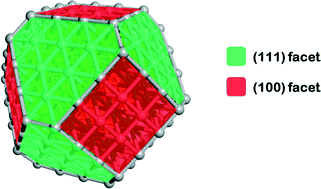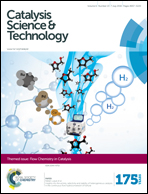Effects of oxygen coverage, catalyst size, and core composition on Pt-alloy core–shell nanoparticles for oxygen reduction reaction†
Abstract
This study focuses on the analysis of Pt-based alloy nanoparticles as electrocatalysts for oxygen reduction reaction in proton exchange membrane fuel cell (PEMFC) technology. The Pt-skin trimetallic core–shell systems of Ptshell–(Re–Ni)core and Ptshell–(Fe–Cn–Fe–Ni)core (n = 12, 24, 36, 42 and 50) are evaluated based on reactivity and stability criteria via density functional theory (DFT) and ab initio molecular dynamics (AIMD) simulations. The oxygen adsorption energy, d-band center, and evolution of the system under PEMFC operating temperature are used as indicators of reactivity, whereas the stability in acid medium is evaluated by the segregation of subsurface catalyst atoms and by the trends of the Pt-skin surface to be dissolved in acid medium. For the Ptshell–(Re–Ni)core system, the reactivity is found to be better than that of pure Pt as shown by the weaker oxygen adsorption strength on the alloy surface and the downshift of the d-band center as well as by the reconstruction of the Pt-skin (100) facets to a more reactive (111) facet observed only on the alloy nanoparticle under both vacuum and oxidative environments. For the alloy stability, the results suggest that the larger nanoparticle (1.5 nm) is more stable than the smaller one (1.3 nm) against segregation of Re shell atoms to the surface, while the segregation of the Ni core to the Re shell for both systems is negligible. Similar trends regarding nanoparticle size are found based on Pt-skin surface dissolution analysis. Other core–shell Pt144–(Fe110–Cn–Ni6)core nanoparticles investigated are composed of a carbide-containing inner layer introduced as a core-anchoring material to avoid segregation of inner metal atoms to the surface. DFT analysis is conducted to determine the optimum composition of the carbide layer that may improve the nanoparticle stability. According to the DFT results, the core-anchoring carbide composition required to enhance both reactivity and stability of the system is between Fe2.6C1.0 and Fe3.1C1.0 as these formulae provide optimal oxygen adsorption strength and prevent segregation of the non-noble atoms. However, the system of a larger size is more favorable to control Pt surface dissolution.


 Please wait while we load your content...
Please wait while we load your content...